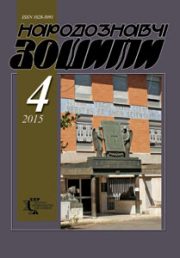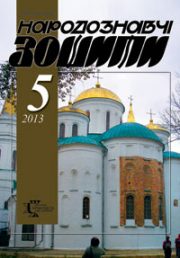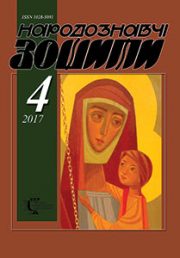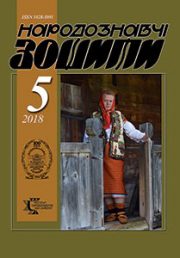The Ethnology Notebooks. 2021. № 3 (159), 507—523
UDK [726.5:008](477.85-11)”15/19″
DOI https://doi.org/10.15407/nz2021.03.507
BELL TOWERS, BELLS AND THE RINGING OF CHURCH BELLS IN FOLK CULTURE OF POKUTTIA
TARAS Yaroslav
- ORCID ID : https://orcid.org/0000 – 0001-7241-9466
- Doctor of Historical Sciences, Professor
- Institute of ethnology of the National academy of sciences of Ukraine,
- Head of the modern ethnology department
- 15, Svobody Avenue, 79000, Lviv, Ukraine,
- Contacts: e-mail: etnomod@ukr.net
Abstract. Introduction. This article provides analysis of the historiography of bell towers, on the basis of it shows a value of sacral building for history and study of building architecture, necessity of their maintenance.
Influences of styles turn out on forming of architectural character and types of bell towers, that took place in Pokuttia in XVI—XVII century and factors that influenced in XVIII century on appearance of separate building for church bells.
Bell towers are characterized by constructive decisions of the wooden churches, their types are given.
It is defined an important value of architectural character of buildings for bells, the completion of their tops. The certain patterns of ceiling are set them by pyramidal tops.
Firmness of tradition of ceiling of bell towers by pyramidal tops turns out. And when the bell towers that have the same composition principles of construction as churches appear but keep the same features of tower, completed by an octahedral tent without an intercept.
The special type of building for bells is educed in Pokuttia — an overgate bell tower on the walls posts, that took place in monasteries and performed the duty of entrance gates and bell tower. Factors that were caused to appearance of this type and representative bell towers are found out.
It is set that the variety of bell towers is given by sound sources, a canopy and an open gallery on archs around a church.
It is shown, what functions executed by Pokuttia bell towers. It is also found out genesis of origin of bell tower that had a pantry. The special attention is spared to the choice of place for a bell tower, the certain patterns of their location are set in relation to the churches of Pokuttia.
The value of ringing and bells is illuminated in a church ceremony, in the folk way of life and folk culture.
The research methodology is based on theoretical analysis, systematization and generalization, historical review and using the method of field ethnography.
Keywords: Pokuttia, building for ringing, bell towers, ringing.
Received 3.06.2021
REFERENCES
- Sichynsky, V. (1925). Wooden bell towers and churches of Galician Ukraine in XVI—XIX centuries. Lviv [in Ukrainian].
- Sichynsky, V. (1988). Ukrainian architecture. In Antonovych А. The Ukrainian culture(pp. 256—290). Munich [in Ukrainian].
- Nahirnyj, E. (1925). Sichynsky V. Wooden bell towers and churches of Galician Ukraine in XVI—XIX centuries. Lviv, 1925 [Review]. Technical news, 7—9, 63. Lviv [in Ukrainian].
- Antonovych, М. (2003). Between two world wars: remembrances (Vol. 1). Kyiv [in Ukrainian].
- Vecherskyj, V., Hodovaniuk, O. & Tymanovych, Ye. (2000). Sights of architecture and town-planning of Ukraine: reference book of the State register of national cultural acquisition. Kyiv [in Ukrainian].
- Moklowski, K. (1903). Folk Art in Poland: in 2 parts. Lviv: Drawing of bookstore of H. Altenberg [in Polish].
- Gloger, Z. (1909). Wooden building and wares in old Poland: in 2 vol. (Vol. 2). Warsaw [in Polish].
- Golubinsky, E. (1904). History of Russian Church: in 2 vol. (Vol. 1). Moscow [in Russian].
- Scherbakivsky, V. (1909). Architecture of different people. Lviv: Drawing of «Folk Word» [in Ukrainian].
- Krasovsky, M. (1916). Course of Russian architecture history. Part 1. Wooden architecture. Petrograd [in Russian].
- Volkov, F.K. (1910). Old wooden churches in Volyn. Materials of Russian ethnography (Vol. 1, pp. 21—44). SPb. [in Russian].
- Antonovych, D. (1923). Brief course of history of the Ukrainian art. Prague: the Ukrainian university in Prague [in Ukrainian].
- Scherbakivsky, D. (1926). The Ukrainian art (L’Art de L’Ukraine). Part ІІ: Bukovynian and Galician wooden churches, graveside and wayside crosses, figures and chapels. Kyiv—Prague: the Ukrainian public publishing fund [in Ukrainian].
- Yurchenko, P.H. (1949). Wooden architecture of Ukraine (XVIII—XIX century). Kyiv: Academy of architecture of Ukrainian SSR [in Ukrainian].
- Yurchenko, P.H. (1970). Wooden architecture of Ukraine. Kyiv: Builder [in Ukrainian].
- Lohvyn, H.N. (1957). Architecture of cult building (churches and bell towers). Essays of history of architecture of Ukrainian SSR (pre-october period) (Pp. 208—231). Kyiv [in Ukrainian].
- Makushenko, P. (1976). Folk wooden architecture of Carpathian Ruthenia (ХVІІІ — the beg. of ХХ century). Moscow [in Russian].
- Karmazyn-Kakovsky, V. (1987). Architecture of Boikos church. Notes of NТSh (Vol.ССІV). New York; Philadelphia: Boikivshchyna [in Ukrainian].
- Mohytych, I.R. (1987). Public building: Bell towers. Churches. Folk architecture of Ukrainian Carpathians of ХV—ХХ century (Pp.181—194, 206—236). Kyiv: Naukova dumka [in Ukrainian].
- Bіlous, F.І. (1877). Churches of ruthenians in Galicia and Bukovyna in comparison with temples of other old people. Kolomyia [in Russian].
- Taras, Ya. (2007). Sacral wooden architecture of Ukrainians of Carpathians: the cultural-traditional aspect. Lviv [in Ukrainian].
- Taras, Ya. (2001). Building for ringing of Ukrainians of Carpathians: sources and placing. Notes of NTSh: Labours of Commission of architecture and town-planning (Vol.ССХLI, pp.317—340). Lviv [in Ukrainian].
- Kindratiuk, B. (2012). Bells culture of Ukraine: monographic research. Ivano-Frankivsk [in Ukrainian].
- Batih, M. (2011). Ringing both cries or laughs: [about ringing of Kutyshche, Tlumach district of the Ivano-Frankivsk region]. Zlahoda, 4, 1—2 [in Ukrainian].
- Bohonis, I. (2008). Worship to the bell-ringer: [about 100-years-old bell-ringer Dmytro Кuzyk from Kolinky]. Kraj, 44, 5 [in Ukrainian].
- Ben-Droniuk, A. (2002). The Artistic casting of the church bells by firm of М.Brylynsky as means of the cultural becoming of christianity in Galychyna. A scientific announcer of Ukrainian University in Moscow (Vol. II, pp. 129—131). Moscow [in Ukrainian].
- Andrey Sheptytsky National Museum in Lviv. Rkl. 18 [in Ukrainian].
- Andrey Sheptytsky National Museum in Lviv. Rkl. 16 [in Ukrainian].
- Svientsitsky, I. (1908). Something about church in old times. Lviv [in Ukrainian].
- Secinskіj, E. (1907). South Russian church architecture. Kamenets-Podolsk [in Russian].
- Krylovskij, A. (1904). Introduction. Arhiv JuZR (P. 1, t. 10, pp. 1—28). Kyiv [in Russian].
- Krylovskij, A. (1904). Arhiv JuZR (P. 1, t. 11). Kyiv [in Russian].
- Tselevych, Yu. (1887). History of Maniavsky skyt. Lviv [in Ukrainian].
- Radovych, R. (2001). House with a roof on wall posts (after materials of Starosambirsky district). The Ethnology Notebooks, 3, 539—542 [in Ukrainian].
- Laba, V. (2014). History of village Dolyna from the oldest times to 1939. Lviv [in Ukrainian].
- Khalebsky, P. (2009). Ukraine — earth of cossacks: the Travelling diary. Kyiv [in Ukrainian].
- Archive of the Institute of Ethnology of the National Academy of Sciences of Ukraine (Archive of IE NASU). F. 1, op. 2, od. zb. 441 [in Ukrainian].
- Archive of IE NASU. F. 1, op. 2, od. zb. 454 [in Ukrainian].
- Rybchynsky, M. & Lysytsyn, A. (2002). Lucha: historical and local lore essay. Lviv; Poltava: Dukhovna vis’ [in Ukrainian].
- Sichovyj Father — Kyrylo Trylovskyj (1992). Chronicle of Kolomyia: popular scientific announcer of museum of history in Kolomyia, 1. Kolomyia [in Ukrainian].
- Nahirny, V. Bells of Kolomyia: manuscript (home archive of М. Savchuk) [in Ukrainian].
- Sanduliak, I. (1974). Village of Karliv from long times to present. Detroit [in Ukrainian].
- Lenkavskyj, S. (2002). When ringing rang above Horodok. In Ukrainian nationalism: works (Vol. 1, pp. 221—230). Ivano-Frankivsk: Lileia-NV [in Ukrainian].
- Myroniuk, M. (2000). History of Korolivka from the oldest times to present. Kolomyia [in Ukrainian].
- Ivaniuk, Kh. (2008). Sacred objects of paternal edge. Galychyna, 17.06, 7 [in Ukrainian].
- Fesiuk, M. (1999). In a valley a village lies [Voskresintsi]. Kolomyia [in Ukrainian].
- Nahirny, V. (2011). Monastyrok. In Recent stories of old city (Pp. 194—197). Kolomyia [in Ukrainian].
- Huzij, R. (2006). World View basis of folk beliefs about rakhmans. History of religions in Ukraine (Vol.1, pp.48—53). Lviv: Logos [in Ukrainian].
- Vajhel, L. (2008). Essay about a Kolomyia city. Kolomyia [in Ukrainian].
- Kupchynsky, B. (2001). Vikno: history of village from the oldest times to present. Ivano-Frankivsk [in Ukrainian].







